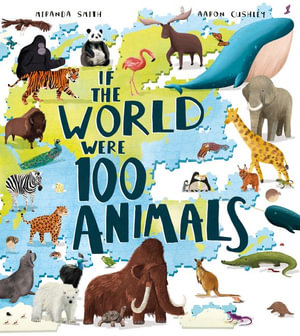If the world were 100 animals by Miranda Smith. Illus. by Aaron Cushley

What a treasure trove of information, presented in a way that is accessible to mid primary aged children and older, filled with colour and maps, illustrations that draw the reader in to look more closely, taking in every detail. I had fun with this book and I am sure many children will too.
To distill the huge numbers of animals, into a base of 100 is awe inspiring. Out of 100 animals in the world 94 are invertebrates and 6 are vertebrates. The invertebrates (those without a backbone) include a huge range of animals, many so small they can only be seen using a microscope.
Out of 100 mammals, 94 are placental, while 5 are marsupial and 1 is a monotreme. The book continues with each double page offering another companion, interesting facts and eye popping numbers. Illustrations cover each page to showcase the animals being spoken of and each is a fascinating spread on which to feast the eyes and take in the science. Readers will want to research some of the new words, adding the animals that fit into the category. Who can go past the word monotreme and not want to know which animals are in that small group?
Some of the pages are just mind boggling. A beautiful double page opens out on its side and illustrates the depth of the sea, with lots of pairs of eyes looking out at the reader, because, of every 100 animals that live in the sea, only 9 are known! No wonder there is lots of sea exploration going on. Another which will give readers cause to stop and think is the 100 animals that live in the wild. In the past all animals were wild, but now only 5 live in the wild, 36 are humans and 59 are found on farms.
A page which children will recognise too is the one about pets. It would be interesting for readers to predict just how many dogs and cats, birds and fish are kept as pets before they open this page. They may be surprised.
And another page which I found fascinating was that of 100 animals, 10 are still living, while 90 have becomes extinct.
On the publication page is information about where the statistics came from and on the last double page is information to make readers think a little further after they have read the book.
A group of kids will greatly enjoy this book, while in a class, it will engender much discussion and research, and looked at alone will be engrossing.
I loved it and I’m sure many others will too. It is a companion to ‘If the world were 100 People' also published by Red Shed, part of the HarperCollins group.
Themes: Animals, Compassion.
Fran Knight